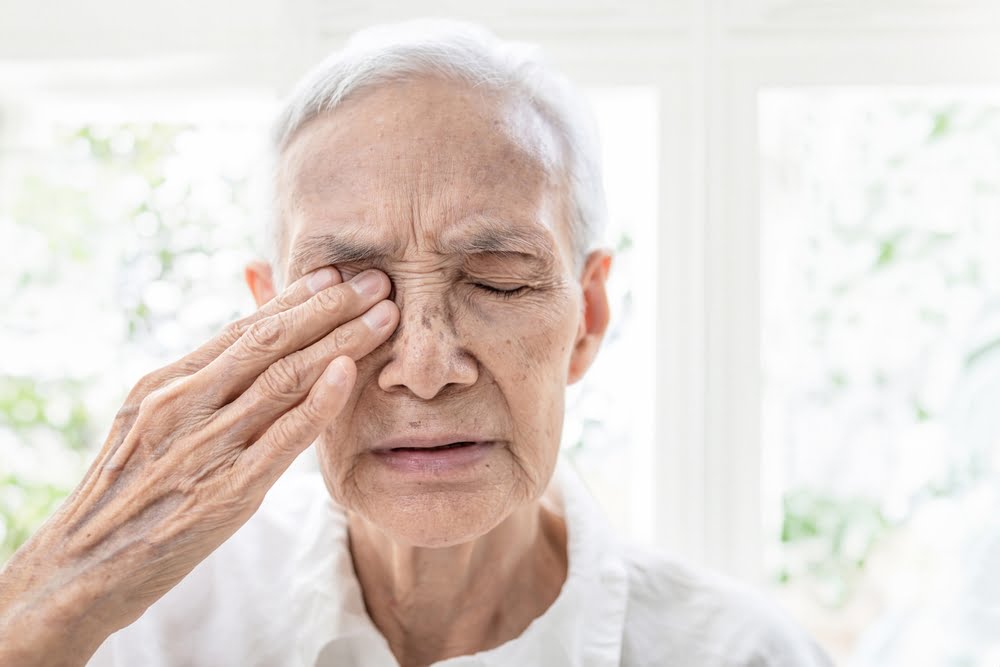
Many of us fear the thought of losing our sight; it’s a concern that feels all too personal and real. We’ve walked in those shoes, faced with the unsettling news that glaucoma might rob us of our vision.
Through dedicated research, however, we discovered crucial insights into recognizing early signs of glaucoma and the significance of timely treatment. This article is crafted to guide you through grasping what glaucoma is about, how it’s diagnosed, and ways to manage it effectively to safeguard your eye health.
Stick around as we dive deeper into this important topic.
Understanding Glaucoma
Glaucoma is an eye disease that occurs when increased intraocular pressure damages the optic nerve, leading to potential vision loss or blindness if not treated promptly. This condition typically results from a buildup of fluid in the front part of the eye, which increases pressure and harms the optic nerve.
It’s essential to understand that glaucoma represents a group of related conditions rather than a single disease, each affecting sight in potentially devastating ways if ignored.
Types of Glaucoma
- Open-angle glaucoma: This is the most common type. It occurs slowly when the eye does not drain fluid as it should, causing intraocular pressure to build up and damage the optic nerve.
- Closed-angle glaucoma: Unlike open-angle, this type develops quickly and is a medical emergency. It happens when the iris blocks fluid drainage suddenly, leading to increased eye pressure, severe eye pain, nausea, redness in the eye, and visual disturbances.
- Normal-tension glaucoma: Optic nerve damage occurs even though intraocular pressure remains within normal ranges. The exact cause is unknown but could include reduced blood flow to the optic nerve.
- Secondary glaucoma: This results from another condition or disease that causes or contributes to increased eye pressure, leading to optic nerve damage and vision loss. Conditions such as diabetes can increase risk.
Each type requires prompt diagnosis and treatment to manage symptoms effectively and prevent blindness. Regular eye examinations are crucial for early detection of these conditions.
Causes of Glaucoma
- Age – As we get older, our risk of developing glaucoma increases significantly.
- Family history – If your family members have had glaucoma, your chances of developing it are higher.
- Eye pressure – People with increased intraocular pressure are more likely to develop optic nerve damage and glaucoma.
- Severe nearsightedness – Having a high degree of nearsightedness can elevate your risk for certain types of glaucoma.
- Diabetes – Individuals living with diabetes face a greater threat of experiencing vision loss due to eye diseases like glaucoma.
- Past eye injuries – Injuries to the eye can lead to secondary forms of glaucoma down the line, affecting vision.
Each factor plays a crucial role in determining someone’s likelihood of facing this progressive eye disease. Acknowledging these risks is vital for early detection and management.
Symptoms and When to Seek Help
- Severe eye pain
- Blurred vision
- Seeing rings around lights
- Loss of peripheral vision
- Blind spots
- Redness in the eye
- Nausea
- Vomiting
We must emphasize the importance of immediate medical attention if you experience a sudden onset of these symptoms. These could indicate closed-angle glaucoma, a serious form that demands urgent care.
Regular eye examinations help detect early signs of optic nerve damage due to increased intraocular pressure before noticeable sight loss occurs.
Diagnosis and Treatment of Glaucoma
How it is Diagnosed
Doctors use several tests to diagnose glaucoma, focusing on measuring the intraocular pressure and examining the health of the optic nerve. They perform a comprehensive eye examination that includes testing for visual acuity and field vision.
- Tonometry tests – Measures eye pressure, which is crucial since increased eye pressure can lead to optic nerve damage.
- Ophthalmoscopy – Allows doctors to look at the shape and color of the optic nerve.
- Perimetry tests – Checks if there are blind spots in your vision caused by early stages of glaucoma.
- Optical coherence tomography (OCT) – Provides detailed images of the optic nerve and helps assess how much damage has occurred over time.
- Gonioscopy – Evaluates whether the angle where the iris meets the cornea is open or closed, this helps distinguish between open-angle and closed-angle glaucoma types.
These diagnostic tools together enable specialists in ophthalmology to detect signs of glaucoma accurately, ensuring patients receive prompt and appropriate care for their eye health.
Management and Treatment Options
- Medications – Eye drops are commonly prescribed to reduce intraocular pressure by either decreasing the production of aqueous humor (fluid within the eye) or improving its drainage.
- Laser Therapy – Laser trabeculoplasty or laser iridotomy can be used to improve the drainage of fluid from the eye, thereby reducing intraocular pressure.
- Surgery – In cases where medications and laser therapy are ineffective, surgical interventions may be necessary to create a new drainage pathway for fluid within the eye.
- Oral Medications – Oral medications such as carbonic anhydrase inhibitors may be prescribed to help lower intraocular pressure, particularly in combination with other treatments.
- Lifestyle Changes – While not direct treatments for glaucoma, certain lifestyle changes such as maintaining a healthy diet, regular exercise, avoiding activities that increase intraocular pressure (like heavy lifting or certain yoga poses), and managing other health conditions like diabetes or hypertension can help manage glaucoma progression.
Complications and Potential Cure
Glaucoma can lead to severe complications, including permanent vision loss or even total blindness if not treated in time. This eye disease damages the optic nerve due to increased intraocular pressure, and without prompt treatment, individuals may face irreversible damage.
The progression of glaucoma can result in a range of symptoms, from mild discomfort to intense eye pain, and eventually significant visual impairment.
On a hopeful note, advancements in ophthalmology have led to potential cures and effective management strategies for those diagnosed with glaucoma. Treatment options vary from prescription eye drops that reduce intraocular pressure to more advanced surgical procedures aiming to relieve the pressure on the optic nerve.
Prevention and Coping with Glaucoma
Tips for Prevention
- Schedule regular eye exams with an ophthalmologist to detect glaucoma early. Experts recommend comprehensive eye check-ups, especially if you’re over 40 or have risk factors like diabetes or a family history of the condition.
- Protect your eyes from injury by wearing protective eyewear during sports or when working with potentially harmful materials. Eye injuries can increase your risk of developing glaucoma.
- Exercise regularly but avoid activities that significantly increase intraocular pressure, such as heavy lifting or inverted yoga positions. Moderate exercise like walking or jogging can help maintain healthy eye pressure levels.
- Monitor and manage other health conditions, notably diabetes and high blood pressure, as they can contribute to increased risk for glaucoma.
- Follow a healthy diet rich in antioxidants. Leafy greens and colorful fruits contain nutrients beneficial for overall eye health.
- Limit caffeine intake to reduce the possibility of increased intraocular pressure, which might lead to optic nerve damage and vision loss associated with glaucoma.
- Use prescribed eye drops correctly even if no symptoms are present. Proper use of medication can prevent progression to more severe visual impairment or blindness due to untreated glaucoma.
Coping with the Disease
Living with glaucoma means adjusting our lifestyle to manage intraocular pressure and prevent further optic nerve damage. Regular visits to an ophthalmologist for eye examinations and visual field tests become a part of our routine.
We also follow their advice on taking prescribed medications accurately to keep the condition under control.
We find support through community groups or connect with others facing similar challenges online, sharing tips and experiences about coping with vision loss while encouraging each other to stay positive despite the progressive eye disease.
Adapting our homes for better safety and ease of navigation becomes crucial, alongside using aids designed for those with visual impairment, ensuring we maintain independence and quality of life even as we deal with glaucoma’s effects.
Questions to Ask Your Doctor
- What type of glaucoma do I have, and how does it impact my vision?
- Can you explain the level of optic nerve damage I currently have?
- What are the treatment options available for my condition?
- How often should I undergo eye examinations to monitor my glaucoma?
- Are there any specific lifestyle changes I can make to help manage my intraocular pressure better?
- Should I be monitoring for any particular symptoms that indicate my condition is worsening?
- How can we address side effects that may arise from the treatment plan?
- Is there a possibility of needing surgery in the future due to my glaucoma?
Begin Healing From Glaucoma Today!
Spotting glaucoma’s signs early and getting treatment can safeguard your vision. Simple eye exams help catch symptoms before they worsen. Have you checked in with an eye specialist lately? Adopting recommended lifestyle changes is a straightforward step towards healthier eyes.
The impact of timely action can mean the difference between preserving sight and severe vision loss. Further exploration into glaucoma research offers hope and advancements in care.
Let this knowledge empower you to prioritize your eye health by booking an appointment with the Plano Eye Associated today!

